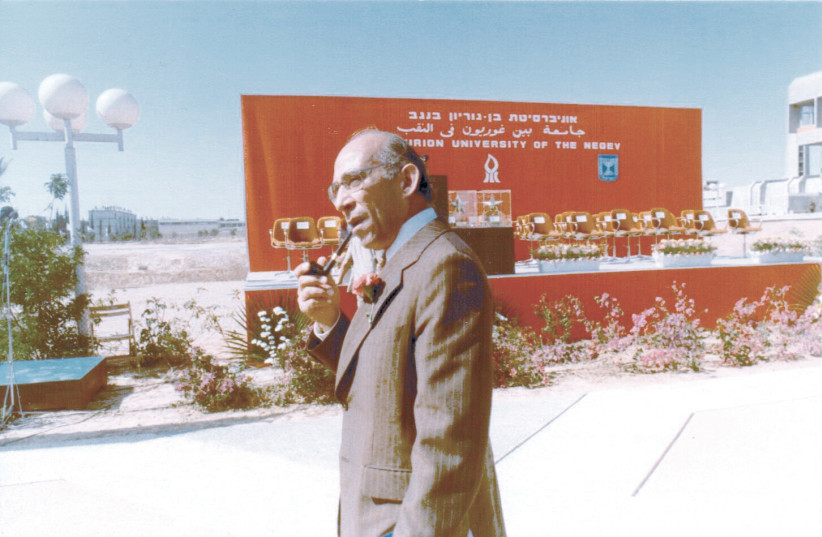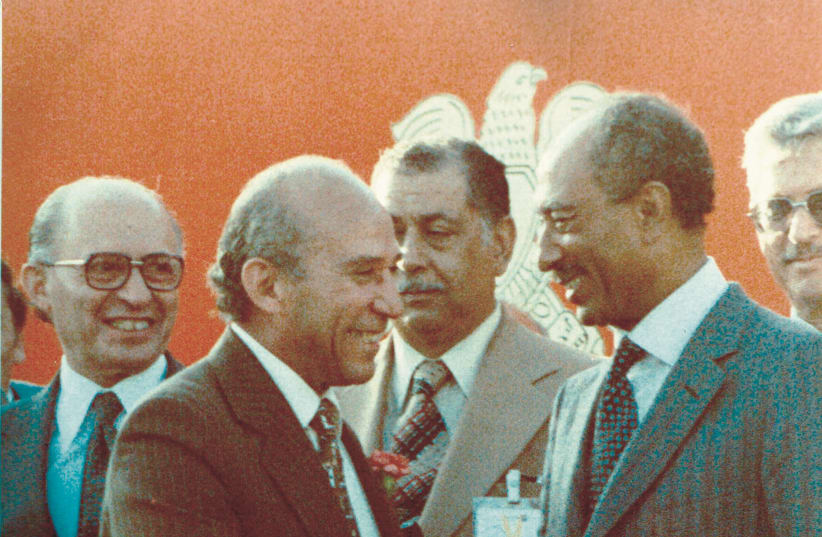
Israel has been blessed by countless contributions by wealthy Jewish donors, philanthropists who have had an enormous impact on all areas of life in the country.
Not all are well-known today. But in the 1970s and ’80s, Swiss financier and industrialist Nessim Gaon had a crucial influence on several of Israel’s social welfare and education programs. And Gaon, who turned 100 on February 22, also proved a persuasive force in developing relations between Israel and Egypt, though almost entirely behind the scenes.
“I lived through some of those events, and sometimes took part,” relates Gaon’s son-in-law, Joel Herzog, President Isaac Herzog’s eldest brother and a close business associate of Gaon. Herzog cites as Gaon’s chief legacies to Israel his contribution to the peace process with Egypt, the creation and promotion of Project Renewal (the Diaspora-Israeli cooperative rebuilding of Israel’s impoverished neighborhoods and development towns), as well as academic scholarships to thousands of underprivileged students.
Nessim Gaon, whose family originated in Turkey, was born in Khartoum, where his father was an officer in the Sudanese government. Gaon joined the British army in Cairo during World War II and saw active service in the Middle East, North Africa and Italy. After the war he joined the family business in Sudan, then moved to Geneva in 1957, where he gradually built up an import-export business that would eventually become the global Noga real-estate and commodity empire. (The company owned a chain of hotels, including Geneva’s Noga Hilton.)
Outside the business world, Gaon became prominent in Jewish and Israeli affairs. In Geneva, a city of 5,000 Jews, he founded Hekhal Haness, the main synagogue in the city, as well as the Jewish school Beit Yossef Girsa. He was vice president of the World Jewish Congress, and in Israel the initiator and funder of a range of social welfare programs, as well as chairman of the board of governors of Ben-Gurion University of the Negev.


Gaon is perhaps best known in Israel as president of the World Sephardi Federation, an organization that he revived in 1971. (Sephardi Jews are descended from traditionally established communities in Spain. The term also refers to Mizrachi Jews from Western Asia and North Africa.) The aim of the Federation was to improve Sephardi education in the Diaspora, and to boost educational and developmental assistance to Israel’s Sephardim. They constitute a slight majority of Israel’s Jewish population, but historically were an overwhelming majority of the Jewish poor.
“The Sephardi Federation was really his baby,” declares one of his two daughters, Marguerite Gaon Herzog, in a recent film on Gaon’s life. “He fought for the Sephardim because he didn’t accept injustice.”
She is referring to how Mizrahi immigrants in the early years of the state were sent to marginalized (“development”) towns and border neighborhoods, and were discriminated against in a variety of ways including in education, housing and access to positions of power.
Described by those who’ve known him as charismatic, very few people know about Gaon’s crucial role on the diplomatic front. Today one accepts the peaceful relations between Israel and Egypt as a given. But in 1977 the rapprochement between the two countries that began with President Anwar Sadat’s November trip to Israel was an astonishing event.
Gaon, who had lived in Egypt, had been serving as a kind of conduit, a mediator between Egypt and Israel, to create an understanding between Sadat and Menachem Begin, Joel Herzog says in a recent telephone interview from his office in Geneva. “They came from such completely different horizons: one an ex-military Egyptian, the other from eastern Europe. One had to bridge these histories. Gaon played a very important role.”
As the Israelis and the Egyptians were secretly formulating a framework for bilateral talks, Herzog relates that Gaon held regular meetings with emissaries from both parties. He would host the Egyptian negotiators in Geneva, and then travel to Israel to liaison with Begin and the Israeli negotiators.
When Begin flew to Ismailia, Egypt, where peace talks got under way, Gaon was part of the entourage. By the end of the year, the American-brokered Camp David Accords between Egypt and Israel were signed. “These were not easy negotiations,” Herzog says in an understatement, adding that Gaon’s behind-the-scenes role had been such that he even provided the pens used to sign the agreement.
Although Gaon maintained his close relations with Begin and members of his Likud party throughout the years, he kept his own political views private. In a 1989 Jerusalem Post interview, he was asked if he agreed with Begin’s ideology. Gaon simply smiled, saying, “On policy matters he had his views and I had mine. We used to argue – he would listen to me and I would listen to him.”
However, when it came to Begin’s views about the Egyptians, Gaon insisted in the interview that he had persuaded him to change his opinions. “I managed to make a dent in the wrong impression he had of the Egyptians. I told him that if an Arab country made a peace agreement with Israel, it would respect that agreement. Nobody in Israel believed that Anwar Sadat sincerely wanted peace. Lack of trust created a gap. What was needed was a little push to get over that gap.”
On June 27, 1979, the first day of the implementation of the Camp David peace agreement, Sadat visited Beersheba and Ben-Gurion University. With him were the Egyptian vice president Hosni Mubarak, Begin, Israeli president Yitzhak Navon, American secretary of state Cyrus Vance, BGU president Shlomo Gazit, and Nessim Gaon, who was then chair of BGU’s Board of Governors. (A decade later, the Gate of Peace at the entrance to the BGU campus was erected in commemoration of the historic visit.)
Gaon’s granddaughter, Arielle Herzog Hadida, today the representative of the Swiss Friends of BGU, says the family only recently learned of the extent of his involvement, “how he was involved in the peace agreement with Anwar Sadat and arranging part of the ceremony that was held at BGU,” she says by phone from Geneva. “It was strange because at the time, BGU was very small, and unknown abroad, nothing like the internationally recognized institution of today. But it happened because Nessim Gaon was involved with the university.”
The population of Beersheba in the 1970s was less than 50,000, made up of mostly poor new immigrants with little education. But there was something that attracted Gaon, explains Joel Herzog.
“At the time he was involved in helping Sephardi residents of the developing towns in the south, and he was working with BGU, among other universities, and they accepted many students from the area. He was very attached to the idea of the development of the Negev and the legacy of Ben-Gurion. He devoted a lot of time and effort in trying to help the university.”
During one of Gaon’s early visits to Israel, he was taken to the Hatikvah quarter in Tel Aviv, where for the first time he saw Sephardim in a dismal plight.
“I couldn’t believe what I saw – five or six persons to a room,” he recalled in the 1989 Post interview. “The authorities told me they couldn’t afford to house the big inflow of immigrants all at once.”
The situation existed throughout the country, with the disadvantaged in large part from the Middle East and North Africa. That experience formed the seed for the concept that would eventually become Project Renewal: to fund the rehabilitation of slum neighborhoods and improve education and social services there.
While Begin would later take credit for launching the project, its inspiration and dogged driving force came from Gaon. He had become close friends with Begin years before the Likud leader became prime minister, and often raised the idea with him.
Gaon was relentless in fund-raising and promoting the program, which – unlike urban renewal projects in other countries – had a direct connection to communities abroad. At times Gaon expressed his frustration at the slow pace the project was taking. He told a 1980 Jewish Agency Assembly that “unless Project Renewal is quickly expedited, human expectations will explode. We counsel patience, but there is just so much suffering people can endure.”
Designed originally as a massive, five-year crash program, the project, in various forms, lasted for more than a decade.
“Gaon would become very involved in all aspects of the project, mobilizing communities around the world to fundraise and to adopt ‘sister cities.’ “He used to visit places to see what was being done,” said Joel Herzog. “He was really hands-on on this project. It gave a huge boost to changing the image of Israel, to give residents pride in their neighborhood because they contributed to the development.”
Years later academic researchers would analyze the achievements, as well as the failures, of Project Renewal, though overall, the perception of the program was one of success.
One of Gaon’s most significant social contributions – one still remembered by thousands of Israelis – was the university scholarship fund for leadership in the development towns. The aim was to give young Sephardim from development towns and disadvantaged neighborhoods the opportunity to study at university, where they would take leadership courses.
The grants were targeted at those who did not have the minimum requirements or the financial means, including many who were already in elected positions in various towns, but who lacked academic qualifications. The idea was to “support them financially, morally, and politically,” as they would then be able to return to their communities to serve in leadership positions. (The Hebrew name for the project is closer to “Project for Public Activists.”)
The project was developed originally at Haifa University, where Gaon was also involved, and within a year was adopted by Ben-Gurion University. Recipients received monthly stipends, including public transportation. “The scholarships had a huge influence on all those involved in the project and their future,” declares Huguette Elhadad Charbit, former director of BGU’s Department of Community Action. “Were it not for Nessim Gaon’s personal funding of the project, it would never have succeeded. All the funding came directly from him until he managed to get matching funds from the Jewish Agency.”
Gaon and his wife, Renee, frequently visited the university to meet with the students. “They were very involved,” says Elhadad Charbit. “It was really wonderful to meet Gaon and his wife. They were so modest and warm, and so informed about everything.”
The only condition for the grants was that the recipients had to return to their towns to contribute to the local population, an agreement that was sometimes difficult to enforce when successful students were offered high-paying jobs in companies in Tel Aviv or other parts of the country. Over the 20 years of the program, there were some 20,000 recipients of the Nessim Gaon scholarships, including many who today are mayors, Knesset members and ministers in the government.
“Nessim Gaon is a real visionary,” states Herzog. “He always had boundless energy and tenacity, as true in business as in his wish to strengthen Jewish life, particularly Israel.” ■
